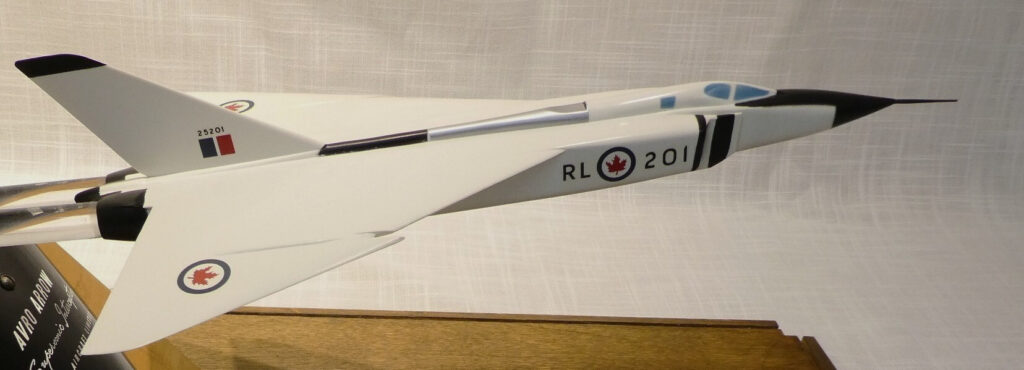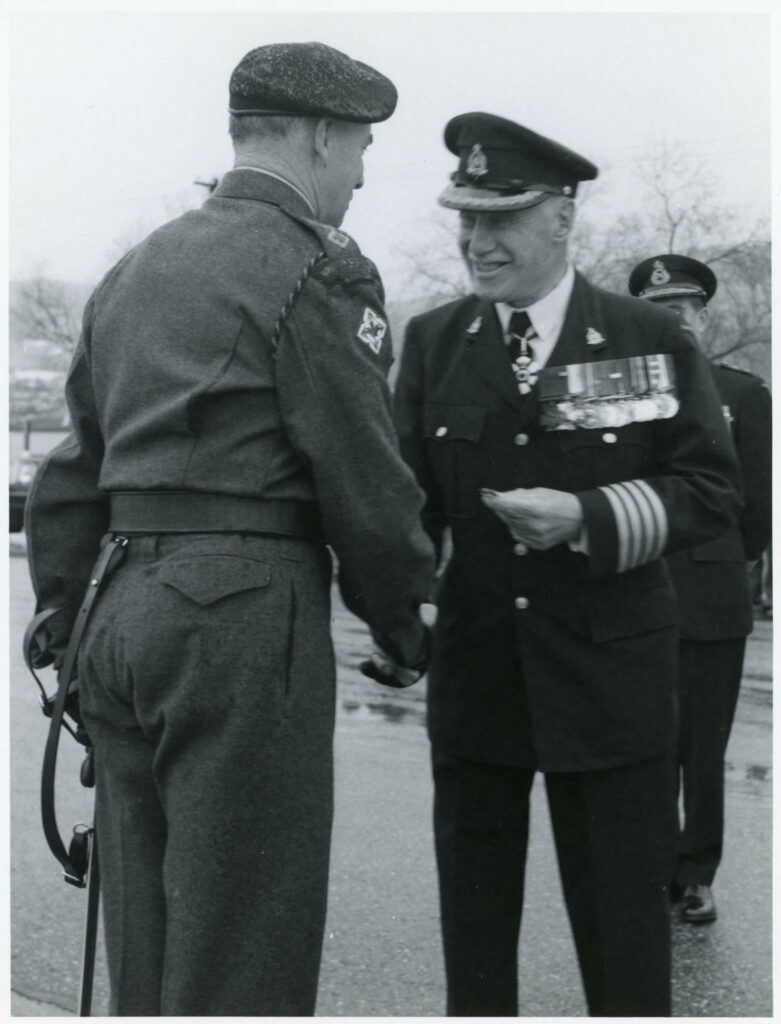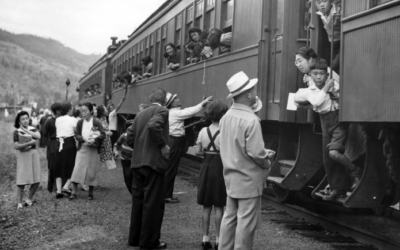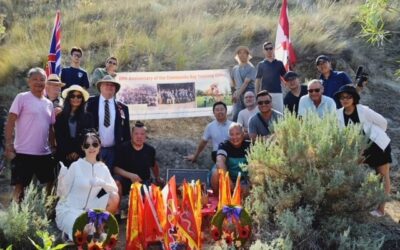February 20, 1959, was the day that the Diefenbaker Conservative government cancelled the AVRO Arrow aircraft program. Much ink has been spent discussing the psychological, economic, and technological impact, including the Canadian identity that this decision had. Major-General George R. Pearkes VC was the Minister of Defence in Prime Minister J. Diefenbaker’s government at the time, and both have been vilified ever since.
While the nexus of the Canadian aviation industry was in southern Ontario and Quebec, there is an Okanagan connection to this event. The relationship starts with George Randolph Pearkes’ service in the Okanagan’s First World War unit, the 2nd Canadian Mounted Rifles (British Columbia Horse). It ends with his service to the British Columbia Dragoons, which perpetuates the battle honours of the 2nd Canadian Mounted Rifles as their Honorary Colonel prior to his death in 1984. In between, George won the Victoria Cross, Distinguished Service Order, and Military Cross for bravery and leadership in combat in the Great War. He served as the commander of the Canadian Army’s Pacific Command in British Columbia during the Second World War and was the Member of Parliament for Nanaimo from 1945 to 1960. George served as Minister of Defence in the Diefenbaker government from 1957 to 1960 and later became British Columbia’s Lieutenant Governor General.
Canadian Author Palmiro Campagna writes in his book released in 2019, The Avro Arrow: For the Record,1 that Pearkes’ recommendation to cancel was based on the return on investment for the government for the huge sums spent to design and build an advanced high altitude supersonic interceptor aircraft, engine, and weapons system in Canada. The government knew it would be expensive to develop and eventually deploy interceptor aircraft to protect Canada’s and North America’s northern airspace from expected waves of Soviet Russian bombers heading south to drop nuclear bombs on American cities. They walked a tightrope to balance Canada’s interests with Washington’s expectations regarding the North American Air Defense Agreement (NORAD), a joint American Canadian command for continental defence, now called North American Aerospace Defense Command. Many documents show that the Canadian government relied heavily upon American intelligence from various agencies regarding Soviet Russia’s capabilities during the Cold War. The Americans were also struggling with the same issues of strategic bombers, interceptors, fighter aircraft and eventually rocketry plus appropriate countermeasures for the same technology emerging in Russia.

OMM-X-353
One shocking surprise was the launching of the first artificial satellite, Sputnik 1, into Earth’s orbit on October 4, 1957.2 Sputnik 2 was launched on November 3, 1957. The first American satellite, Explorer 1, was launched on January 31, 1958.3 Although senior levels of the US government knew of the impending launch by the Soviets, the media reacted with surprise, fear and anger that the Americans were apparently technically deficient and hence the ‘Space Race’ erupted.4 If the Soviets could launch a satellite, they could send a nuclear bomb to Europe and North America on a rocket as an InterContinental Ballistic Missile (ICBM). North Korea’s recent tests echo the same fears in 2024.
Another consideration was the deployment of Bomarc anti-aircraft surface-to-air missiles (SAMs) in Canada. Minister Pearkes may have been aware of the fact the American missiles with their nuclear warheads, located along the CAN/USA border with their 250-mile range, would be launched to explode and destroy the fleets of sub-sonic and supersonic Soviet bombers over the most populated parts of Canada! The plan was to intercept the bombers with jet aircraft from Alaska and Greenland with nuclear-armed missiles, reinforced by missile batteries along the border to protect American cities. The Americans were scaling back on the deployment of aircraft and the development of supersonic bombers, fighters, and interceptors, including cancelling the XF-109 Rapier aircraft program that was remarkably similar to the Avro Arrow.
Pearkes knew Canada could not afford the Arrows and the Bomarc batteries with their associated SAGE radars, computers, and command centres in Canada. The tradeoff for pushing to move the Canadian Bomarc batteries further north was the cancellation of the Arrow program.5
In the 1950s and 60s, no viable anti-IBCM defence systems were in operation or development for North American defence. Within a year of the cancellation of the Arrow, Canada had a need for interceptor aircraft as added information became available from American sources not forthcoming before, and the use of nuclear weapons in Canada caused much debate that neutered the use of the Bomarcs.6
The following is George R. Pearkes’ interpretation of events as related in an interview conducted by Dr. Reginald Roy – April 5, 1967:(ACC 74-1 Box 5, Interview #61)
“I took chances – we were defenceless against the high-powered bomber – we had the old CF-100, it couldn’t compete with the modern Russian bomber; we had no supersonic fighter, but the Americans emphasized the fact that they had lots of them. Now then, the question I had to face… was, if you scrapped the Arrow, you’d got nothing; what will you do? Will you buy American aircraft to fill in this gap – cheaper American aircraft… That’s where people began to tear their hair and say, ‘You scrapped the Arrow, now you’re turning round and buying cheaper (and they would say “not so good”) aircraft – although I think the American aircraft was just as good as the Arrow would have been at any time – or say, ‘here, you can rely on American aircraft, not having bought them, but putting your pride in your pocket’ and saying ‘here, we will give facilities for American fighter squadrons to come and be stationed in Canada so that they can get the advantage there, or if not actually stationed in there, when the situation deteriorates they can move forward and operate from Canadian airfields. And I had the assurance that the Americans at this time had lots of fighters… and I was talking to the Under Secretary of Defence… he said to me, ‘If I was you, I wouldn’t put all that money into that aircraft – if you don’t want to buy aircraft from us, you may rest assured that we’ve got lots of which we can use in the help of the defence of the North American Continent if a crisis comes. And that’s what convinced me more than anything else.” 7,8

BCD-P-1085 Dept. Nat. Def. photo
References
1] Campagna, Palmiro. The Avro Arrow – For the Record, Dundurn Press, 2019
2] The Legacy of Sputnik [Editorial]. (2007). The New York Times, p. 28.
3] Gavin, James Maurice. War And Peace In The Space Age (hardcover) (1958 ed.). Harper. p. 17. ASIN B000OKLL8G. Retrieved 3 April 2015 – via Internet Archive.
4] Wilson, C. (n.d.). “Sputnik: a Mixed Legacy”. US News & World Report, 143(12), (37–38). McQuaid, Kim (2007). “Sputnik Reconsidered: Image and Reality in the Early Space Age”. Canadian Review of American Studies. 37 (3): 371–401. doi:10.3138/cras.37.3.371. S2CID 159948737
5] McLin, Jon B. Canada’s Changing Defence Policy 1957-1963, Baltimore; The John Hopkins Press, 1967 https://en.wikipedia.org/wiki/Semi-Automatic_Ground_Environment
6] US Air Command and Staff College Student Report #86-1575: The Search for an advanced fighter – A history from the XF-108 to the Advanced Tactical Fighter, by Major R.P. Lyons Jr., 1986 https://apps.dtic.mil/sti/pdfs/ADA166724.pdf
7] https://epe.lac-bac.gc.ca/100/205/301/ic/cdc/uvic/pearkes/plv5/parrow.html Campana, Palmiro. Storms of Controversy – The ‘Secret Avro Arrow Files Revealed, Toronto; Stoddart Publishing, 3rd Ed. 1998
8] The Missiles Deadliest Kill by Ian D’Costa, TACAIRNET https://tacairnet.com/2014/12/29/the-missiles-deadliest-kill/



